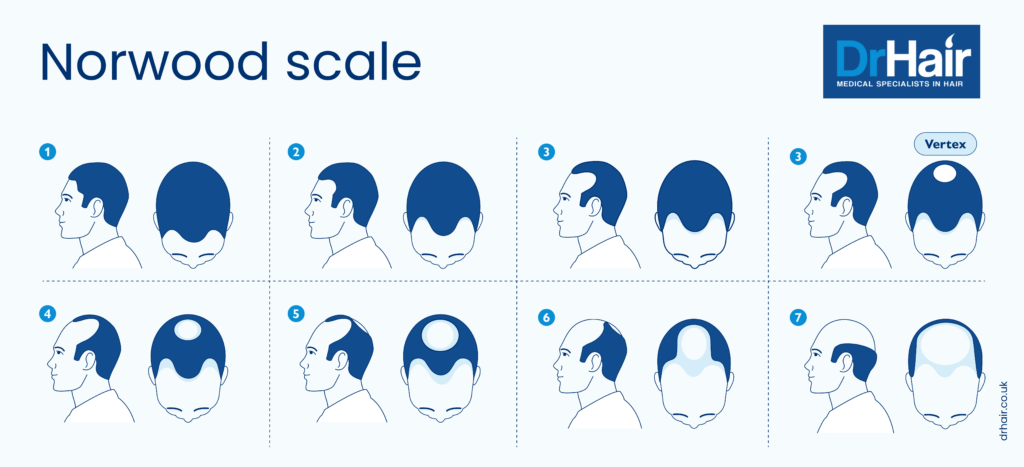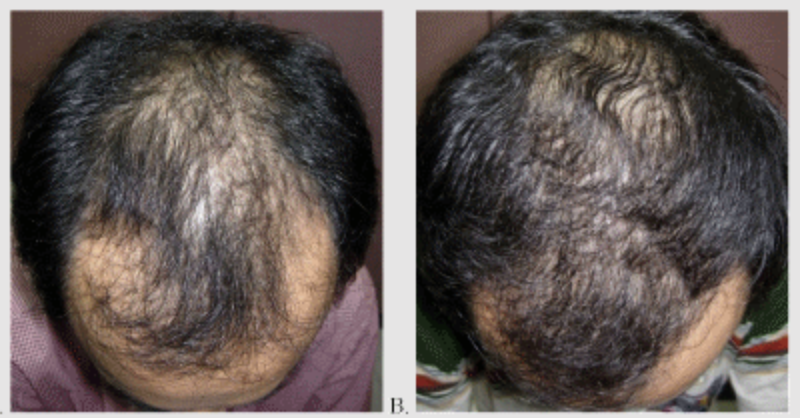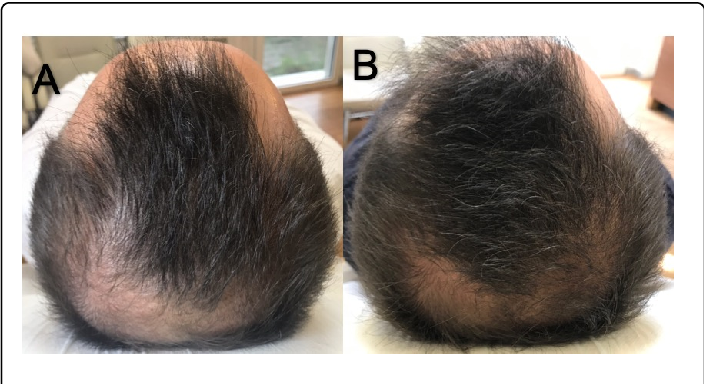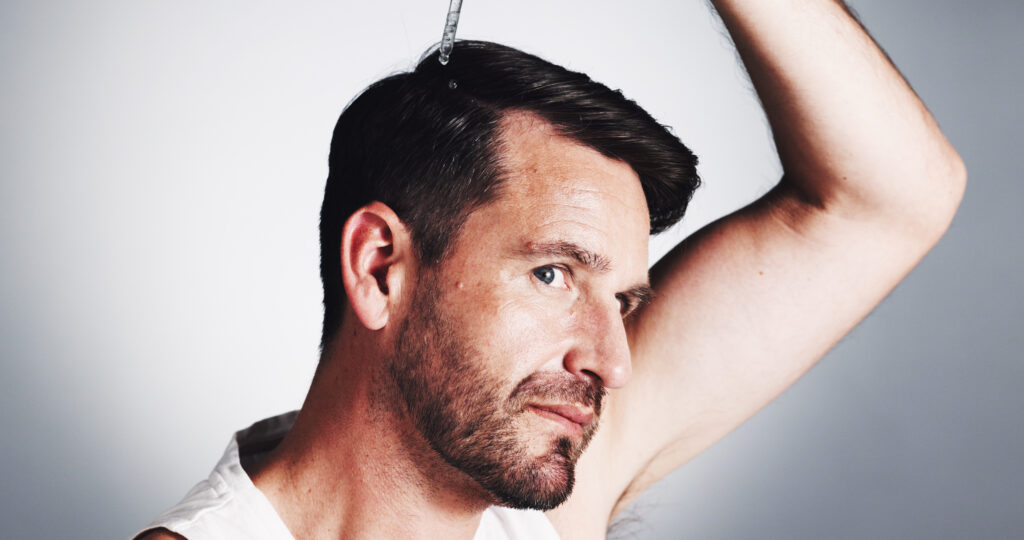Male pattern baldness is the world’s most common hair loss condition, affecting approximately 80% of men [1-2]. So many younger men seek to understand how male pattern baldness is inherited. These genetic factors and influences can shed some light on whether you’re likely to go bald yourself.
Here, we’ll examine how pattern baldness in men is inherited, including:
- The genetic factors leading to male pattern baldness.
- Whether baldness genes are inherited from your mum or dad.
- Other factors that can contribute to hair loss.
- Whether you can prevent or avoid going bald.
Table of Contents
- What causes male pattern baldness?
- Male pattern baldness and genetics: what’s the connection?
- Is male pattern baldness linked to the X chromosome?
- Symptoms of genetic hair loss in men
- Can you prevent inherited male pattern baldness?
- What can I do if I’ve already started going bald?
- What else can make you go bald?
- Male pattern baldness treatments from DrHair
- FAQs
What causes male pattern baldness?
The main factors that contribute to the development of male pattern baldness are:
- Genetics
- Hormones
- Age
Dihydrotestostone, or DHT, is the major hormone involved in male pattern baldness. DHT binds to androgen receptors in your hair follicles, causing them to shrink and stop producing hair.
Your genetics determine your sensitivity to DHT, as well as your natural DHT levels. If you have high DHT levels or a high sensitivity to DHT, this is usually down to the genes inherited from your parents.
Male pattern baldness is a progressive condition, so it gets worse as you get older. That’s why hair loss treatments like minoxidil and finasteride tend to be most effective at a younger age, in the early stages of hair loss. Learn more about what age men start balding.
Male pattern baldness and genetics: what’s the connection?
Contrary to popular myths, there’s no single hereditary ‘baldness gene’ that causes men to lose their hair. Baldness involves several different genes and can be inherited from either parent. According to one study, 63 different genes are associated with genetic hair loss [3].
That said, the AR gene is said to play a significant role in baldness [4]. All men inherit the AR gene from their mother. Variations within this gene can determine when you’ll start losing hair, and the extent of your potential hair loss.
But while the AR gene is always inherited from your mum (if you’re a man), many of the other genes associated with male pattern baldness can be inherited from either parent.
What is the AR gene and how does it cause male pattern baldness?
The AR gene determines your sensitivity to DHT. Men with certain variations within the AR gene may be twice as likely to go bald as men without them [5]. Additionally, if your AR gene expression is high, you may have more androgen receptors in your hair follicles, increasing the potential for hair loss.
Is male pattern baldness linked to the X chromosome?
The AR gene is always inherited via the X chromosome. Men inherit the X chromosome from their mother, which is why it’s commonly said that men inherit baldness from their mum’s side of the family.
But genes linked with baldness can be found on non-X/Y chromosomes too. These can be inherited from either parent, so you can still go bald even if the men on your mum’s side aren’t.
Symptoms of genetic hair loss in men
Male pattern baldness is relatively easy to recognise. It’s a progressive condition that starts with hair loss along your hairline and temples. Left untreated, a bald spot on the scalp may develop, before hair loss becomes more widespread across the scalp.
The Norwood Scale is used to chart the stages of male pattern baldness:

In men, round smooth bald spots, diffuse hair thinning, sudden loss of scalp hair, or balding accompanied by eyebrow hair loss is less likely to be genetic. In these cases, it’s best to speak to your GP before trying any over-the-counter hair loss treatments.

Recommended
Finasteride (1mg) + Minoxidil 5% (60ml)
Inhibit DHT production to halt hair loss and promote hair growth.
Can you prevent inherited male pattern baldness?
If you’re genetically predisposed to going bald, you will eventually start to lose your hair if you don’t take preventative measures. Genetic hair loss is permanent, so if you’re worried about going bald, it’s best to start a preventative treatment early.
Certain treatments have been proven and licensed to stop or slow the progression of male pattern baldness:
- Minoxidil — A topical treatment that should be applied to the scalp twice a day. This stimulates blood flow to the follicles, delivering additional nutrients that help with hair growth.
- Finasteride — An oral tablet to be taken once a day. Finasteride decreases the amount of testosterone that gets converted to DHT, resulting in reduced hair loss. Find out more about the difference between finasteride vs minoxidil.
DrHair is the UK’s leading supplier of minoxidil and finasteride. After decades of supplying these medications to pharmacies and online retailers, individual users can now buy them directly from DrHair at the best prices. Just take our 1-minute assessment to find out if you’re eligible.
What can I do if I’ve already started going bald?
If you already have visible hereditary hair loss, it may not be too late to start treatment. Using minoxidil and/or finasteride in the early stages of hair loss is the best way to prevent further hair loss, and can even stimulate regrowth.

Finasteride results at baseline (A) and after 1 year of daily treatment (B). Source & image credit: [6].

Minoxidil results at baseline (A) and after 24 weeks of twice daily treatment (B). Source & image credit: [7].
These images show that even with visible hair thinning, using finasteride or minoxidil consistently can help you restore at least some of your hair. And if you combine topical minoxidil + oral finasteride, the results can be even more noticeable, giving you thicker, fuller hair without resorting to more invasive measures [8-9]. A topical-only finasteride + minoxidil solution can also boost results while minimising the systemic side effects of oral finasteride.
What else can make you go bald?
While inherited genes are the primary culprit behind the development of male pattern baldness, other factors can also contribute to this. These include:
- Nutritional deficiencies — Lack of certain nutrients, including biotin and zinc, may lead to higher rates of genetic hair loss in men [10].
- Health — Certain conditions, such as high blood pressure and high cholesterol, may be associated with male pattern baldness [11].
- Smoking — Studies suggest smokers are more likely to develop male pattern baldness [12].
And hereditary baldness isn’t the only type of hair loss. Other types of alopecia can cause similar symptoms to male pattern baldness, such as stress-related hair loss and traction alopecia (which is caused by tight hairstyles and extensions). These don’t usually have a genetic cause. So if you’re unsure what’s causing your hair loss, it’s best to speak to a trichologist for a proper diagnosis.
Male pattern baldness treatments from DrHair
If you have early signs of male pattern baldness — such as a receding hairline or increased hair loss in the shower — DrHair can help.
Take a look at our range of hair loss treatments to decide which is best for you. Then take our online assessment to confirm your suitability (it takes less than a minute) and get your chosen treatment for the best price.
FAQs
Learn more about how male pattern baldness is inherited in these FAQs.
It’s possible for male pattern baldness to skip a generation if hereditary hair loss is linked to the AR gene. If your mother’s father had male pattern baldness and you inherit the same causative gene from your mother, you could still go bald, even if your father doesn’t have genetic hair loss.
This doesn’t happen in all cases. Whether you go bald depends not only on the genes you’ve inherited, but also their expression, as well as the impact of other factors.
While you may be more likely to go bald if there are other balding men in your family, there’s no guarantee that you’ll lose your hair if your grandfather is bald. Most men — even those relatively unaffected by male pattern baldness — start to lose their hair as they age. So your grandfather’s baldness may be age-related rather than genetic.
No, not all baldness is inherited. One study found that around 79% of baldness is hereditary [13]. So it’s possible for you to lose your hair even if you have great hair on both sides of the family.
Not usually (although there may be exceptions for trans women and those who were assigned male at birth but no longer identify as male). Women can develop androgenetic alopecia — the scientific name for pattern baldness — but it manifests differently to male pattern baldness. In women, pattern hair loss tends to be diffuse across the scalp, rather than concentrated along the hairline and crown.












